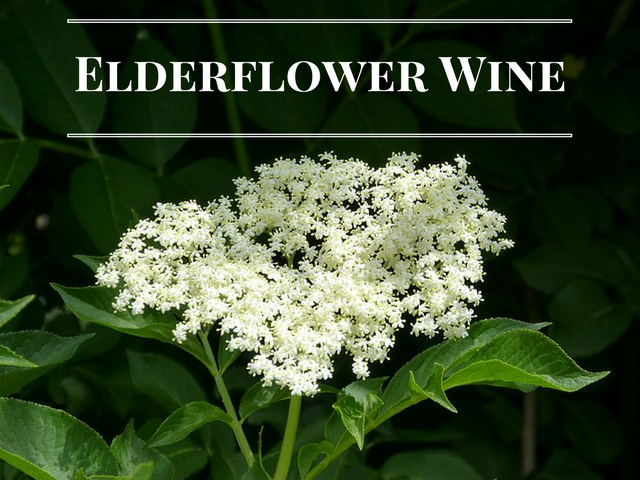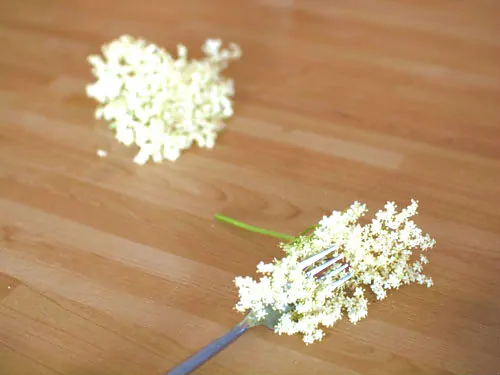Elderflower Wine Recipe – Light To Medium Bodied

Elderflower wine has one of those flavours that is so distinct you cannot really compare it to anything else.
That elusive floral bouquet seems to be amplified in a wine and the number of elderflower bushes in the UK makes it one of the most popular ingredients for wine making.
Most people opt to make elderflower champagne but in all honesty, I prefer an elderflower wine, the elderflowers really do fill the palate even without the bubbles.
Elderflowers have a unique flavour all of their own in most cases you either like it or you don’t.
If you like something like an elderflower cordial or presse then this wine recipe really does showcase that distinct flavour and aroma.
Table of Contents
Picking Elderflowers
As Elderflower bushes are so abundant around the UK finding and picking Elderflowers is your best option for making wine.
One of the great benefits of elderflowers in the use of winemaking is the ease of harvesting.
The flower heads grow in umbels so it is just a case of snipping the whole flower head at the base of the umbel.
When harvesting the flowers I would recommend taking a few from each bush you encounter rather than taking all the flowers from each bush.
It should be noted that if you are picking your own Elderflowers that you are 100% certain you have correctly identified the plant as an elder bush.
Once you spot a few bushes they are quite easy to identify using a field guide for confirmation.
When to Pick Elderflowers
Elderflowers will start appearing in early June so keep an eye out for them at this point.
If they stay on the bush too long the flowers will start to go brown. You should be able to harvest some throughout June into July in most places in the UK.
When you go picking take a curved handled walking stick and you’ll be able to hook down branches to get some of the florets that are higher up on the bush.
To make a gallon of this wine you will need roughly 24 elderflower heads which should take you no time at all to pick. Any more than this and the wine can become a little too pungent.
Using Dried Elderflowers
You can make this wine with dried elderflowers should you not be able to pick your own.
As they are dried you will need to use a lot less, check the details of the recipe down below for exact quantities.
Preparing The Elderflowers
When you pick the Elderflowers, give them a gentle shake to dislodge any debris or bugs before putting them in an open container.
If you seal the container or bag the flowers will sweat and turn brown.
You can wash the flower heads whilst they are intact and this is recommended, especially, if you picked the flowers next to a bust road.

You will also need to strip the flowers from the stalks, the best way to accomplish this is once the flowers are picked and are dry grab a fork and comb the flowers from the stalks into a bowl.
It’s a fairly simple process and will result in a much better wine.
Making Elderflower Wine
The equipment needed for this Elderflower wine recipe is fairly straightforward.
You will need the following items:
What You’ll Need To Make Elderflower Wine – Makes 1 gallon / 4.5 litres
- Fermenting Bucket
- Demijohn
- Large Pan
- Funnel
- Syphon
- Fine Straining Bag / Sieve
- Airlock & Bung
Elderflower Wine Ingredients
- 24 Elderflower heads, flowers removed from stalks or 20g Dried Elderflowers
- 1.2kg of Sugar
- 4 litres of Water
- 1 Campden tablet
- 1 Lemon
- 1 tsp Yeast Nutrient
- 1/4 tsp Wine Tannin
- 1 Sachet of Wine Yeast (Our recommendation is Lalvin 71B 1122)
Elderflower Wine Method
- Remove the zest from the lemon taking care not to grate the white pith, and add this to the sanitized fermenting bucket along with the Elderflowers.
- Bring 4 litres of water to a boil and add the sugar to dissolve, pour over the flowers and the lemon zest. Allow to cool and add the Campden tablet, yeast nutrient, tannin and the juice of the lemon, mix and leave for 24 hours.
- After 24 hours pitch the yeast into the fermenter, allowing the wine to ferment for at least 6 days until activity starts to slow down.
- After the initial burst of fermentation activity pass the wine through a sieve or straining bag into a sanitised demijohn. It is probably easiest to accomplish by placing a funnel in the demijohn with a sieve or straining bag in it.
- Let the Elderflower wine complete fermentation and condition in the demijohn for at least a 2 – 3 months, racking off the sediment as and when needed. Check this guide for more information.
- Once cleared you may wish to stabilise the wine and back sweeten before bottling, this Elderflower wine is best sampled after around 6 months but will last well for a year or two.




I have made some elder flower wine and it has gone black can anybody tell me why and can I save it
Hi Barry, this sounds very strange and not something I have encountered myself. There seems to have been a reaction of some kind to make the wine turn black.
It may be just quite brown at the moment. Where the flowers removed from the stems? It could be that there is a lot of tannin in solution. Any more information would be great.
Hi
What ABV would this wine be? is there anything I could do to make it stronger or weaker?
kind regards
The amount of sugar in this recipe will produce wine around 13%. To increase the ABV to 14% you would need about 100g more sugar. If you go much higher than this the yeast will stop before all the sugar has fermented and leave a residual sweetness in the wine.
Hope this helps
Hi I boiled my elderflower for 30 mins with lemon will it be ok or should I start again
It will be fine. You are adding sugar and yeast after the solution has cooled so it will still make wine. Boiling the flowers may drive off some delicate aromas but it is not a problem. Hope it goes well.
I have followed your recipe and made 2 batches however they are different colours one is a bit lighter than the other I used exactly the same ingredients is it because I picked the flowers from different areas where I live
I have had this happen before and it is quite a common occurrence. The age of the flowers may make a difference and also oxidization of the wine can have an effect on colour. If you want a uniform colour between the two batches, sample them to make sure they taste the same and then blend both wines together before bottling.
Hi. I have transferred my wine from bucket to demi John but fermentation seems to have stopped. Should I add more sugar or yeast?
The fermentation will stop producing carbon dioxide when the sugar has been converted to alcohol. There is no need to add more sugar, the yeast will still be working and removing byproducts from the fermentation.
Hi, I have made the elderflower wine and it is due to be bottled but on tasting it is very dry and unsweet. Will this come back later or should I add more sugar now?
Thanks
If the wine is too dry then you can backsweeten it with sugar using the following guide – https://homebrewanswers.com/back-sweeten-wine/
Just finished my first racking of this wine and as you do, had a wee sample. What a beauty she is. The flavour is amazing. Thank you Neil for a great recipe and guidance. I’ve got a plum and a damson on the go and again used Neil’s recipe. Can’t wait to try those. Many thanks again. Cheers
Glad you like it! Cheers
I’m going to try this recipe as written today! Also wondering if I can substitute honey for some or all of the sugar?
Yes, honey will really boost the flavour of the wine. You will need to add around 1.2 – 1.3 times the amount of honey in place of the sugar to achieve the same amount of fermentables.
Hey Neil,
I’ve made 2 batches of elderflower wine this year following your recipe, but I’ve found them both to be extremely bitter rather than sour. I used dry flowers & picked them over to remove any odd stalks so not sure where the bitterness is coming from. I am now ready to bottle & decided to back sweeten to see if it helped the bitterness issue. I have a bottle of Belvoir elderflower cordial (completely natural) & thought I’d try backsweetening with that & wow, completely transformed, you wouldn’t believe it was the same wine. I will now backsweeten any wine I make with natural cordials, so much nicer than plain old sugar.
Love this site & it’s my go to for any info/recipes, keep up the good work Neil.
All the best & cheers
Pauline
Sounds great Pauline, thank you for the kind words!
Hi there, looking to use this recipe and make two batches in two 1 gallon (5ltr) demijohns. I am using CY17 wine yeast which should be fine but your recipe calls for the whole sachet of yeast, the packet says dosage is 19-25 ltrs. Would I be ok splitting this packet between two 1 gallon demijohns? Thanks
Should probably add the sachet is Mangrove Jacks CY17 and net weight of sachet is 8g
Yes you can split the sachet between multiple batches if you want.
Hi Neil,
Thanks for the clear and straightforward guide – I’m giving this a go using half sugar and half honey (using the 1.2 ratio as commented above).
What’s your thoughts on adding some Pectolase during the first 6 day bucket fermentation step to help with extraction / clarity?
Many thanks,
Toby
Pectolase will help break down the flowers but there is not as much pectin as there would be in fruit. It definitely won’t hurt the clarity and extraction to use it.
Hi Neil,
My hubby (another Neil) doesn’t like elderflowers, so all the more for me and friends! I tried this recipe for the first time during lockdown and was very pleased with the results. I am just in the process of starting this year’s batch. Hoping it’s as good 🙂
The only thing I changed was to snip off the florets with sharp scissors rather than the fork method.
Best of luck and hope it works just as well this time!
This will be my first serious try at the blossom instead of the berry. I have 1 acre to play with, I planted 11 bushes 5 years ago, 2 of them were close enough together to grow together into a huge bush. They keep getting bigger every year. My first wine from berries I used a yeast that would make a high alcohol wine, up to 19 per cent alcohol. It settled at 16 per cent alcohol and was so delicious I drank two large glasses of it. My head started spinning, I laid down in bed, the ceiling was spinning, I tried to get out of the bed to go in the bathroom to try to vomit, hoping for relief from the spinning, fell on the floor and passed out for 2 hours til my girl friend came home and woke me up. She wasn’t, I was, great tasting, get you there quick, don’t drink too much at a time. So now I’m ready to try the blossoms from my own bushes. John Rabeler, still experimenting…
Hope this time works just as well!